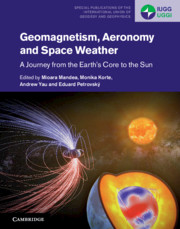Book contents
- Geomagnetism, Aeronomy and Space Weather
- Special Publications of the International Union of Geodesy and Geophysics Series
- Geomagnetism, Aeronomy and Space Weather
- Copyright page
- Contents
- Contributors
- Preface
- Part I Introduction
- Part II Geomagnetic Field
- Part III Spatial and Temporal Variations of the Geomagnetic Field
- 9 Spatial and Temporal Changes of the Geomagnetic Field
- 10 The Global Lithospheric Magnetic Field
- 11 The Ionospheric Field
- 12 The Magnetosphere
- 13 Temporal Field Variations
- Part IV Space Weather
- Part V Magnetic Fields beyond the Earth and beyond Today
- Index
- References
10 - The Global Lithospheric Magnetic Field
World Magnetic Anomaly Maps and Models
from Part III - Spatial and Temporal Variations of the Geomagnetic Field
Published online by Cambridge University Press: 25 October 2019
- Geomagnetism, Aeronomy and Space Weather
- Special Publications of the International Union of Geodesy and Geophysics Series
- Geomagnetism, Aeronomy and Space Weather
- Copyright page
- Contents
- Contributors
- Preface
- Part I Introduction
- Part II Geomagnetic Field
- Part III Spatial and Temporal Variations of the Geomagnetic Field
- 9 Spatial and Temporal Changes of the Geomagnetic Field
- 10 The Global Lithospheric Magnetic Field
- 11 The Ionospheric Field
- 12 The Magnetosphere
- 13 Temporal Field Variations
- Part IV Space Weather
- Part V Magnetic Fields beyond the Earth and beyond Today
- Index
- References
Summary
The magnetic field generated in the Earth’s lithosphere carries information on the Earth history and tectonics. It is therefore worthwhile studying, but gathering magnetic data for this purpose is a task requiring time and significant ressources. This has been the main objective of the World Digital Magnetic Anomaly Map (WDMAM) project. We recall here the main steps that led to the first and second versions of the map. We further discuss the models that have been derived from the map, and finally describe recent works to interpret these models in term of magnetisation of the crust. We see these recent developments as major steps forward for an efficient exploitation of the magnetic data collected near the surface of the Earth.
- Type
- Chapter
- Information
- Geomagnetism, Aeronomy and Space WeatherA Journey from the Earth's Core to the Sun, pp. 133 - 140Publisher: Cambridge University PressPrint publication year: 2019

